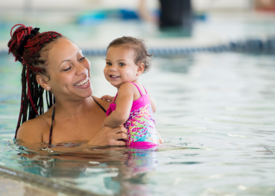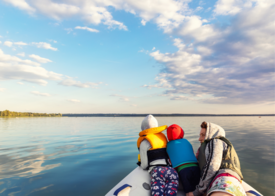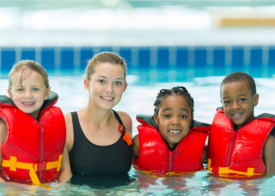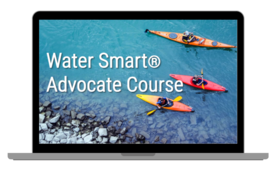Top 10 Water Smart® Tips
Follow these tips to stay safe when in, on, or around water:
Follow these tips to stay safe when in, on, or around water:

1. Choose it - Use it! Always Wear a Lifejacket or Personal Flotation Device (PFD):
Don’t just have it in the boat. Pick one and wear it. Lifejackets work like seatbelts and bicycle helmets. By the time you need one, it's too late to put it on.

2. Closely Supervise Young Children In, On, and Around the Water:
93% of drowning incidents in children under 5 years old occurred due to absent or distracted supervision (Canadian Drowning Report 2024). If you’re not within arm's reach, you’ve gone too far.
3. Always Swim with a Buddy:
Never participate in an aquatic activity alone. The safest places to play and swim in are areas supervised by a lifeguard.
4. Avoid Swimming in the River:
Rivers come with many unpredictable risks like moving water, undercurrents, changing depth, and entrapment hazards. If participating in other aquatic activities on the river, like boating or floating, make sure to wear your lifejacket and follow these other water safety tips.

5. Boat, Ride, and Swim Sober:
Alcohol and drugs impair your judgement and can even exacerbate the effects of the sun and water.
6. Know Before You Go & Make a Plan:
When getting ready for a day on the water, pay attention to the weather forecast and complete a simple safety checklist.

7. Learn to Swim and Learn Lifesaving Skills:
Learning to swim can save your life! Or go further and take other Lifesaving Society programs like Canadian Swim Patrol, Bronze Medallion, Bronze Cross, National Lifeguard. Contact your local pool or aquatic facility for more information.
8. Drive Powerboats, Personal Watercraft and Snowmobiles Responsibly:
Look before you act, stay low, drive at moderate speeds, be aware of changing weather conditions, and drive with extreme caution and proper lights after dark. Make sure you get your Pleasure Craft Operator (PCO) Card, and if you don't have one, take the Lifesaving Society's Boat Operator Accredited Training (BOAT)™ course.
9. Use Designated Ice Surfaces:
These are regulated by personnel and are the safest to use. If using other ice surfaces, do not go out on thin ice, and wear a thermal protection buoyant suit. Remember, no ice is ever 100% safe.
10. Protect Your Neck:
Never dive into shallow water. If you're unsure of how deep the water is, enter feet first.

To learn more about how to be safe in, on, and around water, take our free online Water Smart® Advocate course!